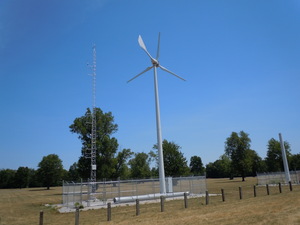
Thomas Corke and Robert Nelson, professors of aerospace and mechanical engineering, have installed a wind turbine in White Field and will soon add another. The turbines help power the Wind Tunnel Facility located in White Field, but their primary purpose is to support cutting-edge research in the Laboratory for Enhanced Wind Energy Design (eWiND). The researchers aim to demonstrate that through the development of advanced rotors featuring a Notre Dame-patented plasma flow control technology, they can increase power generation and extend the life span of wind turbine systems while reducing their weight and decreasing their cost.
“One of the two wind turbines has been operating for about 7 months. Data from it and from the meteorological tower has been recorded 24/7 and stored for processing”, Corke said. “The second wind turbine will be operating near the end of August.”
Potential challenges in using wind energy are not insurmountable. Although vast amounts of space are needed for extensive wind farms, the opportunity for mixed use function is high and many times cattle graze and crops are planted right up to the base of the turbine, greatly reducing its “footprint”. Wind power produces no greenhouse gas emissions during operation. Although in the short-term the wind acts as an intermittent source of energy, the year-to-year energy output is reasonably consistent. In addition, wind is widely distributed and available to everyone, making it more “democratic” than fossil fuels and other centralized energy sources. All these traits support wind energy’s strong potential for more widespread use in the future.
The cost of harnessing wind power becomes more affordable each year— according to the Department of Energy, the cost of wind power has declined from more than $0.80/kWh in 1980 to less than $0.08/kWh today. Last year, the global wind energy capacity grew by 17.3% and the United States produced 19.7% of global wind power. Nonetheless, wind energy is still not economical in many cases. Through the recent wind installation and ongoing research in the eWiND Lab, Notre Dame researchers seek to increase wind turbine efficiency and therefore make this renewable energy source more economical and widely utilized.